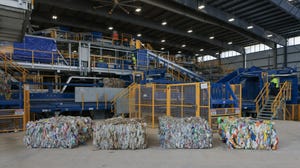The Appeal of Peels in Peel
April 1, 2007
D. Trevor Barton
IN APRIL, the Region of Peel, a collection of three municipalities west of Toronto, Ontario, launched a weekly organics recycling program. Household organic material, such as food scraps and soiled paper products, are collected and processed into a useful end product — clean, rich compost.
“This is a big change in the way we manage waste in the Region of Peel,” says Andrew Pollock, Peel's director of waste management. “Currently, household organic material makes up approximately 30 percent of our garbage, and we're confident that with high resident participation in the program, we can divert this material from disposal.”
The program was simultaneously rolled out to 285,000 households that receive curbside waste collection services in the cities of Brampton and Mississauga and the town of Caledon, Ontario. To date, it is the largest launch of an organics recycling program in Canada.
Collected organic material is processed at two regional facilities: the composting plant at the new Peel Integrated Waste Management Facility in Brampton, which can process 60,000 metric tons per year, and the Caledon Composting Facility at the Caledon Landfill Site, which can process 12,000 metric tons per year.
Once the finished compost is created, it is sold to gardening centers and landscaping companies. Residents also can purchase compost at Peel's community recycling centers. Pollock says that this “made-in-Peel” approach to waste contributes to environmental sustainability.
Though the program only went region-wide in April, organics recycling has been in practice for more than a decade in select areas of Peel. In 1994, the region implemented a biweekly organics recycling program in Caledon, which has yielded high participation rates to date.
In 2002, Peel introduced weekly curbside organics collection to approximately 1,700 households in Brampton, Caledon and Mississauga. The pilot program was used to evaluate bin designs, household set-out rates, effectiveness of public education and promotion initiatives, and perceived barriers to participation.
“The experience of the Caledon program and the pilot project were encouraging, and the Peel Regional Council approved staffs' proposal to implement a region-wide organics recycling program,” continues Pollock.
Norseman Plastics Ltd. was responsible for the design, manufacturing and delivery of the two bins used in the program: a 12-gallon wheeled green bin used for curbside collection, and a two-gallon beige kitchen container used to collect material in the home. Workers delivered 285,000 bin sets during a six-week period prior to launch, with approximately 50,000 bins delivered each week.
Each bin set was delivered with a manual about the program, a magnet listing approved and forbidden items, and the 2007 “Waste Management Guide,” containing information on all of Peel's waste and recycling programs.
Non-compostable plastics, such as grocery bags and food wrap, are not permitted in the bins, as they contaminate the finished compost. Instead, residents have the option of lining their bins with newspaper, paper bags or certified compostable plastic bags.
Pollock notes that rolling out a new program of this magnitude requires a significant behavior change for residents. He says the Region of Peel worked with Toronto-based Fingerprint Communications to develop a multi-faceted strategy to educate residents.
“The organics recycling program is an important component of Peel's long-term goal of diverting 70 percent of its waste from landfills by 2016,” Pollock says. “The diversion of organic material from the waste stream will reduce Peel's dependency on landfills, which is good news from both an environmental and economic perspective.”
— D. Trevor Barton
Supervisor, Waste Management Planning, Region of Peel
You May Also Like


